Analysis of the Acceleration Response Spectra of Single-Layer Spherical Reticulated Shell Structures
Abstract
:1. Introduction
2. Methodology
2.1. The Reticulated Shell Structures without a Roofing System
2.2. The Reticulated Shell Structures with a Roofing System
3. Results
4. Discussion
4.1. The Reticulated Shell Structures without a Roofing System
4.2. The Reticulated Shell Structures with a Roofing System
5. Conclusions
- (1)
- The applicability of Chinese, American, and European codes to the seismic design of the nonstructural components in single-layer spherical reticulated shells was analysed. The current codes are mostly based on the characteristics of horizontal floor response spectra of multistorey or high-rise buildings. The acceleration response characteristics of a node in a reticulated shell structure are significantly different from those suggested in the codes, so the current codes cannot be directly applied.
- (2)
- The roofing systems influence the dynamic performance of the shell and affect the seismic acceleration response of the shell node in each ring. The constraints of the bolted purlin roofing system are relatively weak, and the horizontal and vertical acceleration response characteristics of the shell with a bolted purlin roofing system are close to those of the shell without a roofing system. The seismic response of the shell nodes is obviously affected by the high-order vibration modes of the shell, which are not fully considered in the current codes. The phenomenon of the shell nodes near the support where the horizontal acceleration response exceeds the specification requirements is more serious. The reticulated shell structures are more sensitive to vertical seismic excitation, which leads to an increase in the vertical acceleration response as the ring approaches the central node of the shell. The strength and stiffness of the purlin joint in a welded purlin roofing system are larger, the dynamic characteristics of the shell will more obviously change, and the membrane stiffness and out-of-surface bending stiffness of the shell nodes will significantly improve. The seismic action can be transmitted more efficiently in the shell with a welded purlin roofing system, leading to the phenomenon that the horizontal and vertical acceleration response of the shell nodes tend to increase as the ring approaches the central node of the shell.
- (3)
- The acceleration response spectra of the shell node under three-dimensional ground motions were theoretically analysed based on the complete quadratic combination method. The difference in the membrane stiffness of the shell node in different directions will affect the seismic response of the shell node near the support, and the influence of the membrane stiffness of the shell nodes and the seismic input direction should be considered in the analysis of the acceleration response spectra of the shell nodes near the support. In this paper, the calculation method for the acceleration response spectra of the nodes in a single-layer spherical reticulated shell without a roofing system was proposed.
- (4)
- In the shell with a bolted and welded purlin roofing system, the larger the rise-to-span ratio of the shell with the same span, the higher the shell node height and shorter the horizontal distance in the same ring from the support. This leads to the phenomenon that the horizontal amplification coefficients (AF0) of the seismic acceleration amplitude for the representative node in each ring of the shell tend to increase with the increase in the rise-to-span ratio and that the vertical amplification coefficients of a shell with a 1/3 rise-to-span ratio are smaller than those of the shells with other rise-to-span ratios. Generally, the horizontal and vertical amplification coefficients (AFmax) of the acceleration spectra peak value tend to increase with increasing effective distance (Di).
- (5)
- The acceleration response spectra of the nodes in the shell with a roofing system were studied by the time history analysis method, and design methods were proposed for the horizontal and vertical seismic action of the nonstructural components in shells with bolted and welded purlin roofing systems.
Author Contributions
Funding
Institutional Review Board Statement
Informed Consent Statement
Data Availability Statement
Acknowledgments
Conflicts of Interest
References
- Fan, F.; Zhi, X.; Shen, S. Failure Mechanism of Reticulated Shells under Earthquake; Science Press: Beijing, China, 2014. [Google Scholar]
- Pilarska, D.; Maleska, T. Numerical Analysis of Steel Geodesic Dome under Seismic Excitations. Materials 2021, 14, 4493. [Google Scholar] [CrossRef] [PubMed]
- Li, H.W.; Li, J.; Zhi, F. A parameter study on dynamic buckling of spatial arch trusses under seismic action. In Proceedings of the 6th International Conference on Computation of Shell and Spatial Structures IASS-IACM 2008, New York, NY, USA, 28–31 May 2008. [Google Scholar]
- Jie, Q.; Shizhao, S.; Heng, G. Dynamic Field Test on Elliptical Suspen-dome. In Proceedings of the 6th International Conference on Computation of Shell and Spatial Structures IASS-IACM 2008, New York, NY, USA, 28–31 May 2008. [Google Scholar]
- Li, J.; Xu, J. Dynamic Stability and Failure Probability Analysis of Dome Structures under Stochastic Seismic Excitation. Int. J. Struct. Stab. Dyn. 2014, 14, 1440001. [Google Scholar] [CrossRef]
- Nair, D.; Ichihashi, K.; Terazawa, Y.; Sitler, B.; Takeuchi, T. Higher mode effects of multistorey substructures on the seismic response of double-layered steel gridshell domes. Eng. Struct. 2021, 243, 112677. [Google Scholar] [CrossRef]
- Miranda, E.; Mosqueda, G.; Retamales, R.; Pekcan, G. Performance of Nonstructural Components during the 27 February 2010 Chile Earthquake. Earthq. Spectra 2012, 28 (Suppl. 1), 453–471. [Google Scholar] [CrossRef]
- Kenichi, K. Damage to Non-Structural Components in Large Room by the Japan Earthquake; Structures Congress: Chicago, IL, USA, 2012. [Google Scholar]
- Dezhang, S.; Yong, H.; Zhenyu, Y. Seismic damages of typical nonstructural components in the Ms7.0 Jiuzhaigou earthquake. Earthq. Eng. Eng. Dyn. 2019, 39, 27–34. [Google Scholar]
- Ministry of Housing and Urban-Rural Development of the People’s Republic of China. Code for Seismic Design of Nonstructural Components; Planning Press: Beijing, China, 2015.
- American Society of Civil Engineers. Minimum Design Loads for Buildings and Other Structures; ASCE Standard: Reston, VA, USA, 1998. [Google Scholar]
- European Committee for Standardization. Design of Structures for Earthquake Resistance-Part 1, General Rules, Seismic Actions and Rules for Buildings, European Standard; European Committee for Standardization: Brussels, Belgium, 2004. [Google Scholar]
- Miranda, E.; Taghavi, S. Approximate Floor Acceleration Demands in Multistory Buildings. I: Formulation. J. Struct. Eng. 2005, 131, 203–211. [Google Scholar] [CrossRef]
- Taghavi, S.; Miranda, E. Approximate Floor Acceleration Demands in Multistory Buildings. Ⅱ: Applications. J. Struct. Eng. 2005, 131, 212–220. [Google Scholar] [CrossRef]
- Singh, M.P.; Moreschi, L.M.; Suarez, L.E.; Matheu, E.E. Seismic Design Forces. I: Rigid Nonstructural Components. J. Struct. Eng. 2006, 132, 1524–1532. [Google Scholar] [CrossRef]
- Singh, M.P.; Moreschi, L.M.; Suarez, L.E.; Matheu, E.E. Seismic Design Forces. II: Flexible Nonstructural Components. J. Struct. Eng. 2006, 132, 1533–1542. [Google Scholar] [CrossRef]
- Wang, X.; Astroza, R.; Hutchinson, T. Seismic Demands on Acceleration-sensitive Nonstructural Components Using Recorded Building Response Data-case Study. In Proceedings of the 10th National Conference in Earthquake Engineering, Anchorage, AK, USA, 21–25 July 2014. [Google Scholar]
- Fathali, S.; Lizundia, B. Evaluation of Current Seismic Design Equations for Nonstructural Components in Tall Buildings Using Strong Motion Records. Struct. Des. Tall Spec. Build. 2011, 20 (Suppl. 1), 30–46. [Google Scholar] [CrossRef]
- Oropeza, M.; Favez, P.; Lestuzzi, P. Seismic Response of Nonstructural Components in Case of Nonlinear Structures Based on Floor Response Spectra Method. Bull. Earthq. Eng. 2010, 8, 387–400. [Google Scholar] [CrossRef] [Green Version]
- Sullivan, T.J.; Calvi, P.M.; Nascimbene, R. Towards Improved Floor Spectra Estimates for Seismic Design. Earthq. Struct. 2013, 4, 109–132. [Google Scholar] [CrossRef]
- Politopoulos, I. Floor Spectra of MDOF Nonlinear Structures. J. Earthq. Eng. 2010, 14, 726–742. [Google Scholar] [CrossRef]
- Calvi, P.; Sullivan, T.J. Estimating Floor Spectra in Multiple Degree of Freedom Systems. Earthq. Struct. 2014, 7, 17–38. [Google Scholar] [CrossRef]
- Calvi, P.; Sullivan, T.J. Improved Estimation of Floor Spectra in RC Wall Buildings. In Proceedings of the NCEE 2014-10th U.S. National Conference on Earthquake Engineering: Frontiers of Earthquake Engineering, Anchorage, AK, USA, 21–25 July 2014. [Google Scholar]
- Petrone, C.; Magliulo, G.; Manfredi, G. Seismic Demand on Light Acceleration-sensitive Nonstructural Components in European Reinforced Concrete Building. Earthq. Eng. Struct. Dyn. 2015, 44, 1203–1217. [Google Scholar] [CrossRef]
- Samit, R.C.; Hutchinson, T.C. Effect of Nonlinearity of Frame Buildings on Peak Horizontal Floor Acceleration. J. Earthq. Eng. 2011, 15, 124–142. [Google Scholar]
- Qin, Q.; Li, Y. Design Floor Spectra for Nonstructural Components and Equipment in Buildings. J. Tsinghua Univ. 1997, 37, 82–86. [Google Scholar]
- Qin, Q.; Nie, Y. Seismic Design and Simplified Analytical Method of Nonstructural Components and Equipment in Buildings. J. Build. Struct. 2001, 22, 15–20. [Google Scholar]
- Xiaolan, P.; Zhi, Z.; Zhenyu, W. A Multi-Mode Method for Estimation of Floor Response Spectra. J. Earthq. Eng. 2016, 22, 1111–1136. [Google Scholar]
- Jiang, W.; Li, B.; Xie, W.-C.; Pandey, M.D. Generate floor response spectra: Part 1. Direct spectra-to-spectra method. Nucl. Eng. Des. 2015, 293, 525–546. [Google Scholar] [CrossRef]
- Jiang, W.; Li, B.; Xie, W.-C.; Pandey, M.D. Generate floor response spectra: Part 2, Response spectra for equipment-structure resonance. Nucl. Eng. Des. 2015, 293, 547–560. [Google Scholar] [CrossRef]
- Badillo-Almaraz, H.; Whittaker, A.S.; Reinhorn, A.M. Seismic Fragility of Suspended Ceiling Systems. Earthq. Spectra 2007, 23, 21–40. [Google Scholar] [CrossRef]
- Tian, Y.; Filiatrault, A.; Mosqueda, G. Seismic Response of Pressurized Fire Sprinkler Piping Systems I: Experimental Study. J. Earthq. Eng. 2014, 19, 649–673. [Google Scholar] [CrossRef]
- Filiatrault, A.; Higgins, P.S.; Wanitkorkul, A. Experimental Seismic Response of Base Isolated Pallet-type Steel Storage Racks. Earthq. Spectra 2008, 24, 617–639. [Google Scholar] [CrossRef]
- Zhi, X.; Zhang, T.; Li, W.; Feng, F. Effect of Roof System on Elasto-plastic Stability and Seismic Performance of Single-layer Reticulated Shells. China Civ. Eng. J. 2017, 50, 19–26. [Google Scholar]
- Zhang, T. Research on Earthquake Coupling Effects of Space Truss Structure with Roofing System and Piping System. Master’s Thesis, Harbin Institute of Technology, Harbin, China, 2018. [Google Scholar]
- Pei, X.; Zhang, L.; Ren, L. Time History Analysis Method for Seismic Response of High-Rise Building Structures; China Water & Power Press: Beijing, China, 2006. [Google Scholar]
- Hu, L. Earthquake Engineering; Seismological Press: Beijing, China, 2009. [Google Scholar]
- American Society of Civil Engineers. Seismic Analysis of Safety-Related Nuclear Structures and Commentary; ASCE Standard: Reston, VA, USA, 1998. [Google Scholar]
- Ministry of Housing and Urban-Rural Development of the People’s Republic of China. Technical Specification for Space Frame Structures; China Planning Press: Beijing, China, 2010.
- Cao, Z.; Zhou, C.; Wan, Z. Seismic Response Analysis of an 80-metre Span Single-layer Reticulated Dome with Bolt-ball Joints. J. Harbin Inst. Technol. 2017, 49, 58–65. [Google Scholar]
- Li, W.; Zhi, X.; Wang, D.; Fan, F.; Shen, S. Static Stability Analysis of a Reticulated Shell with a Roofing System. Eng. Struct. 2019, 185, 315–331. [Google Scholar] [CrossRef]
- Li, W.; Zhi, X.; Wang, D.; Fan, F.; Shen, S. Influence of a Roofing System on the Static Stability of Reticulated Shells. Adv. Steel Constr. 2020, 16, 363–369. [Google Scholar]
- Ministry of Housing and Urban-Rural Development of the People’s Republic of China. Code for Seismic Design of Building; China Planning Press: Beijing, China, 2016.





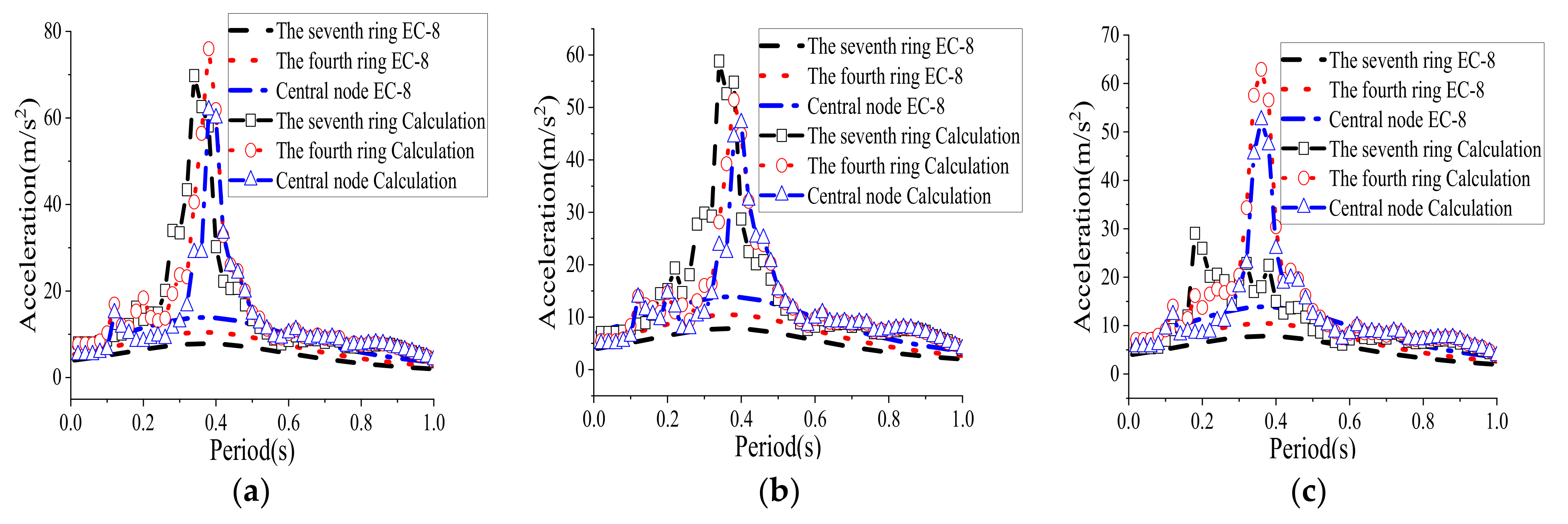


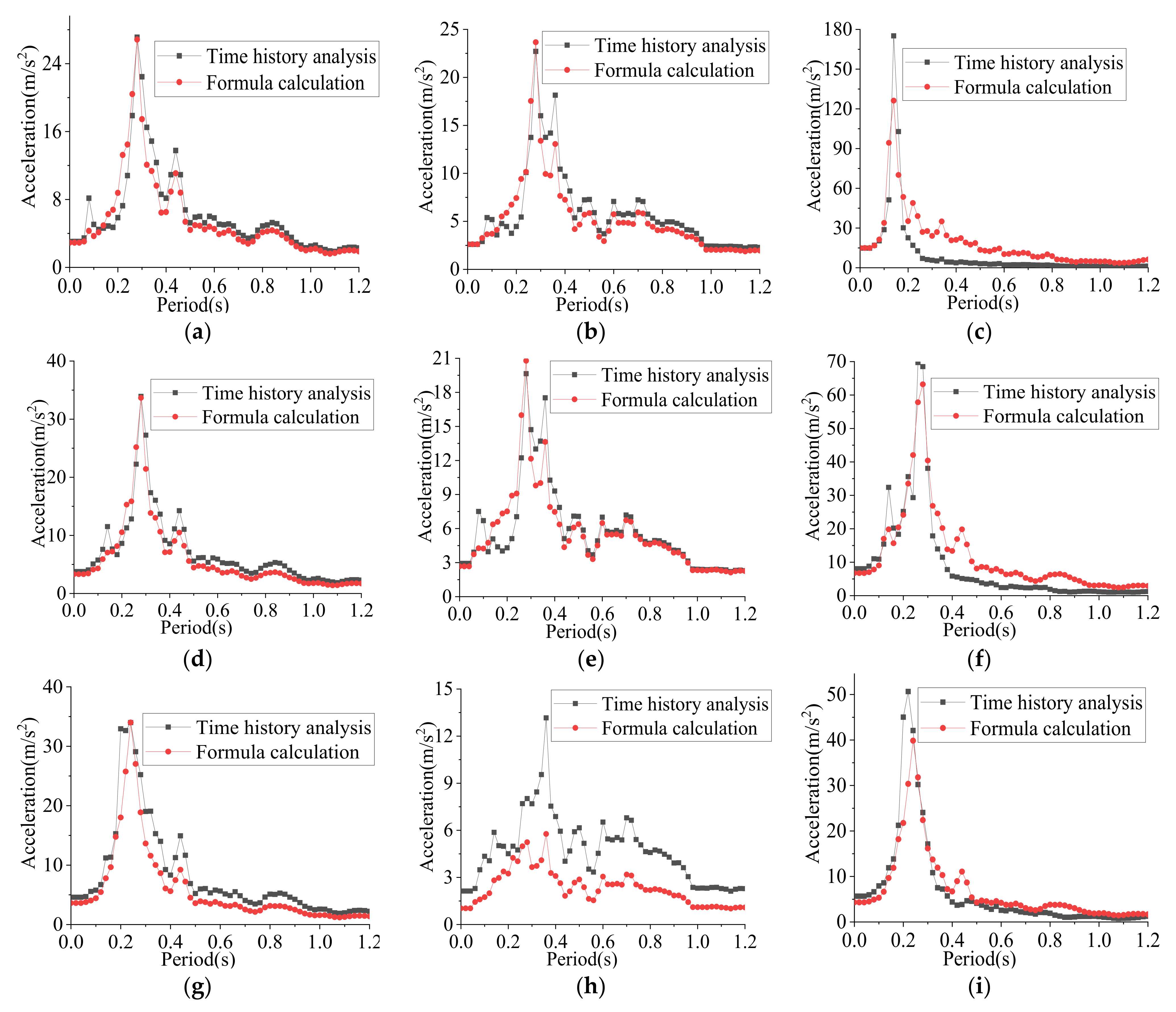
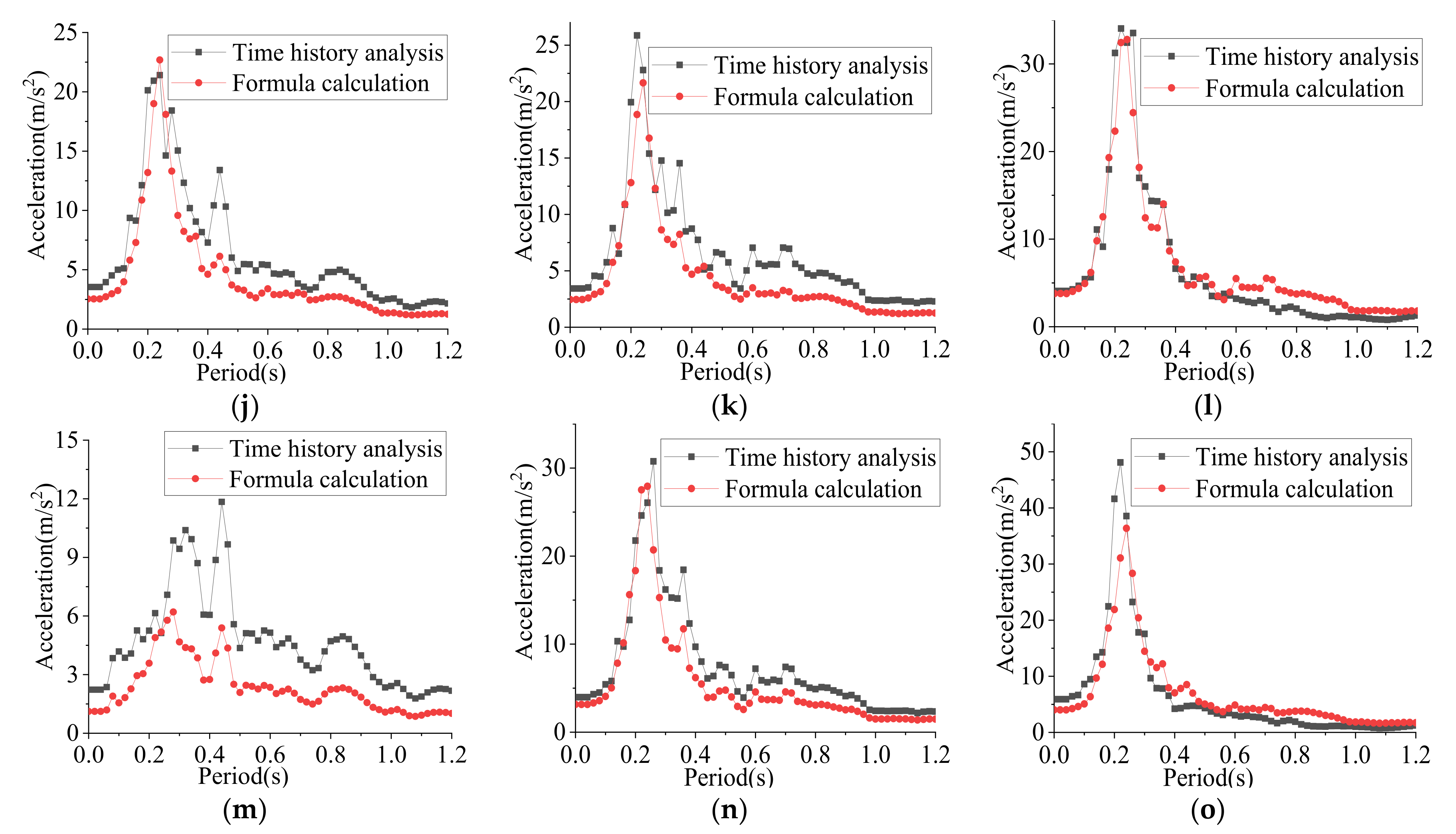
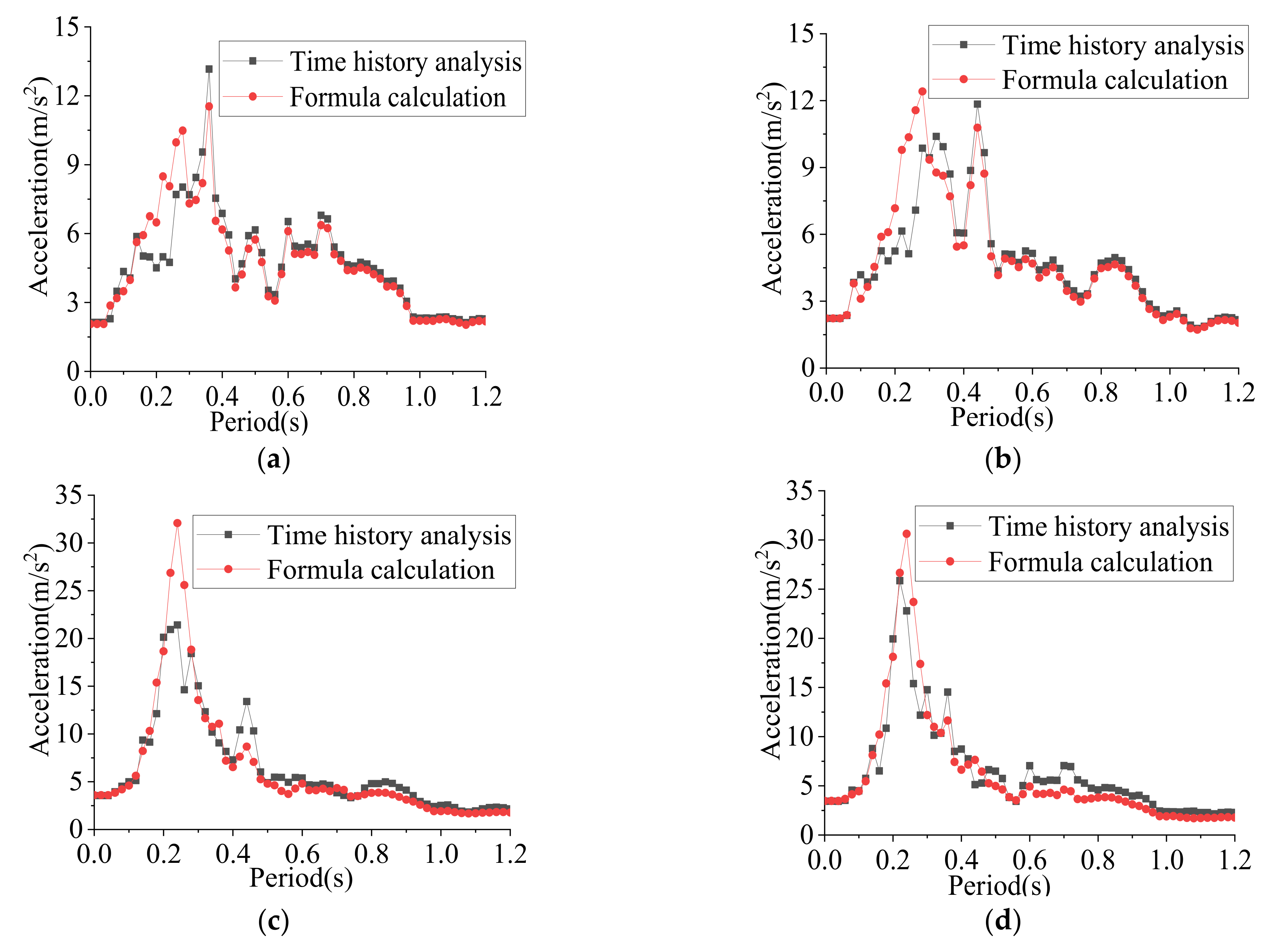
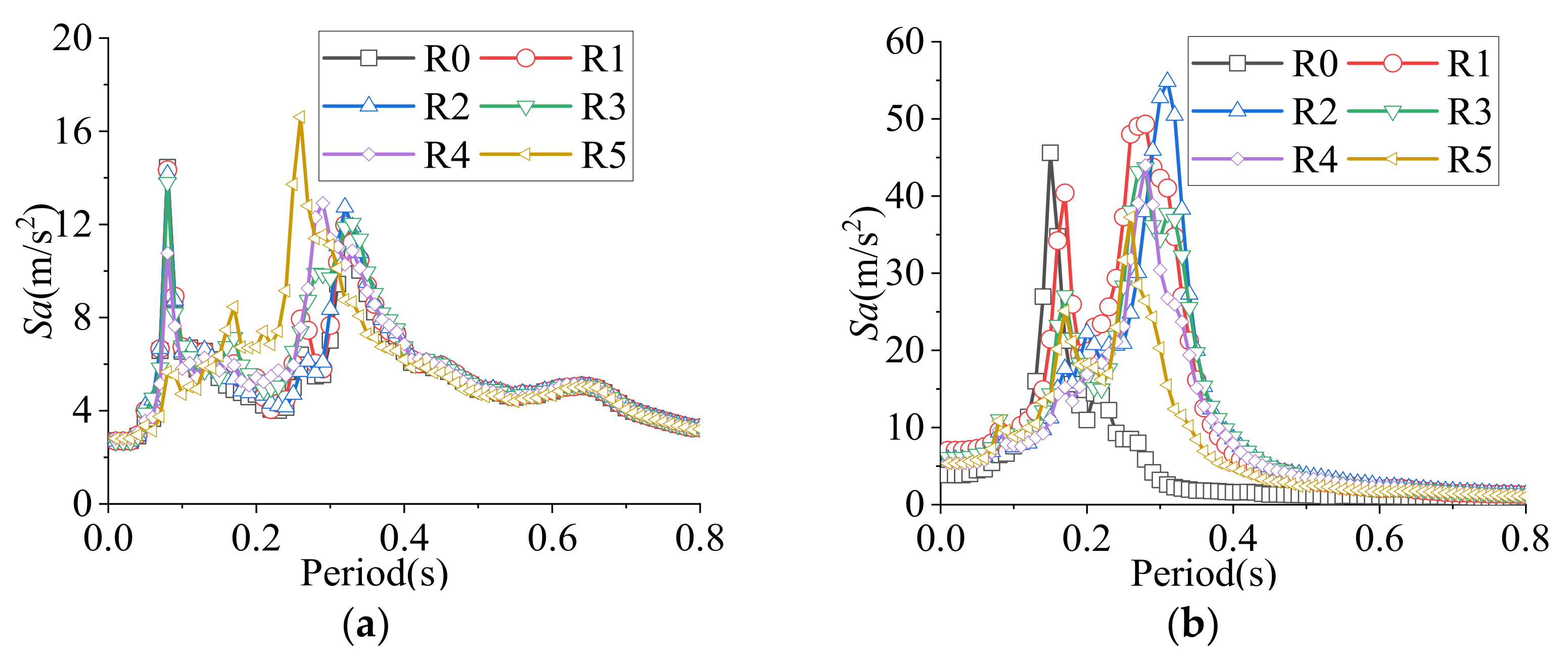

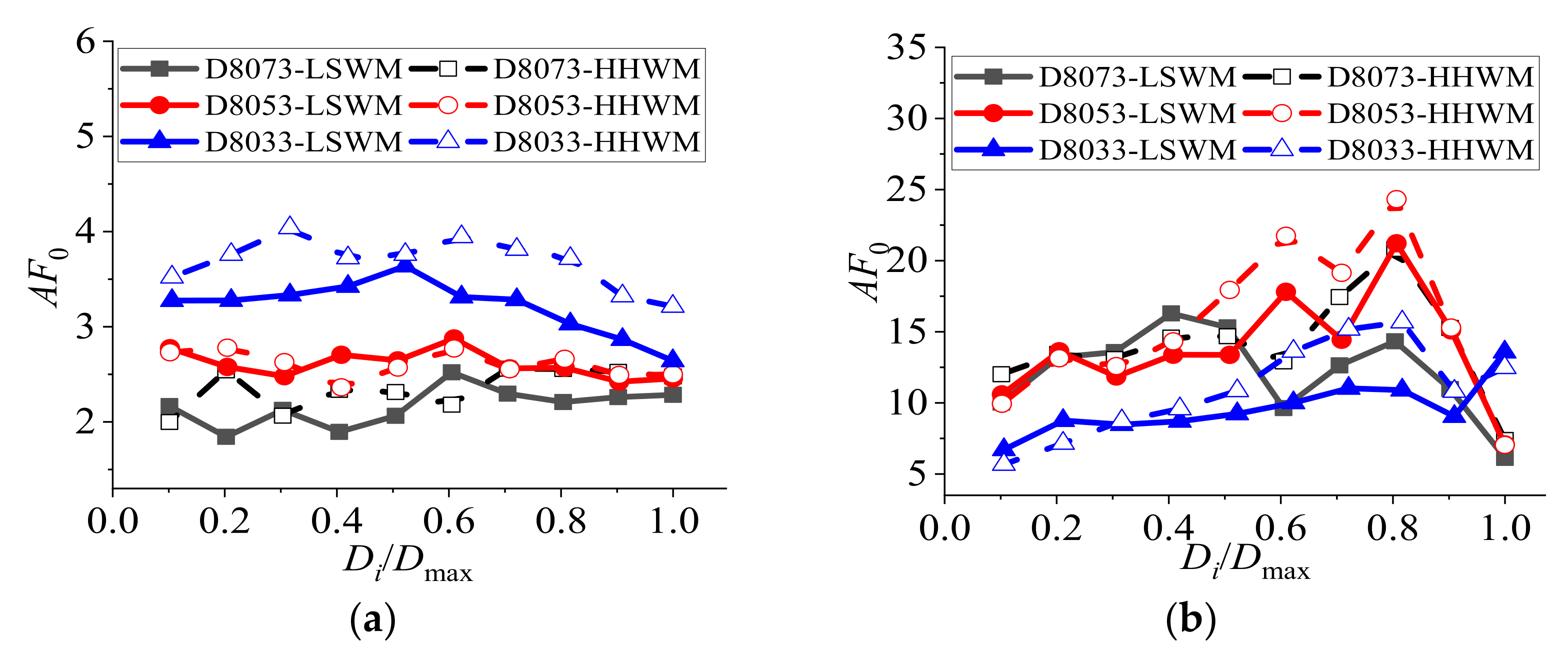
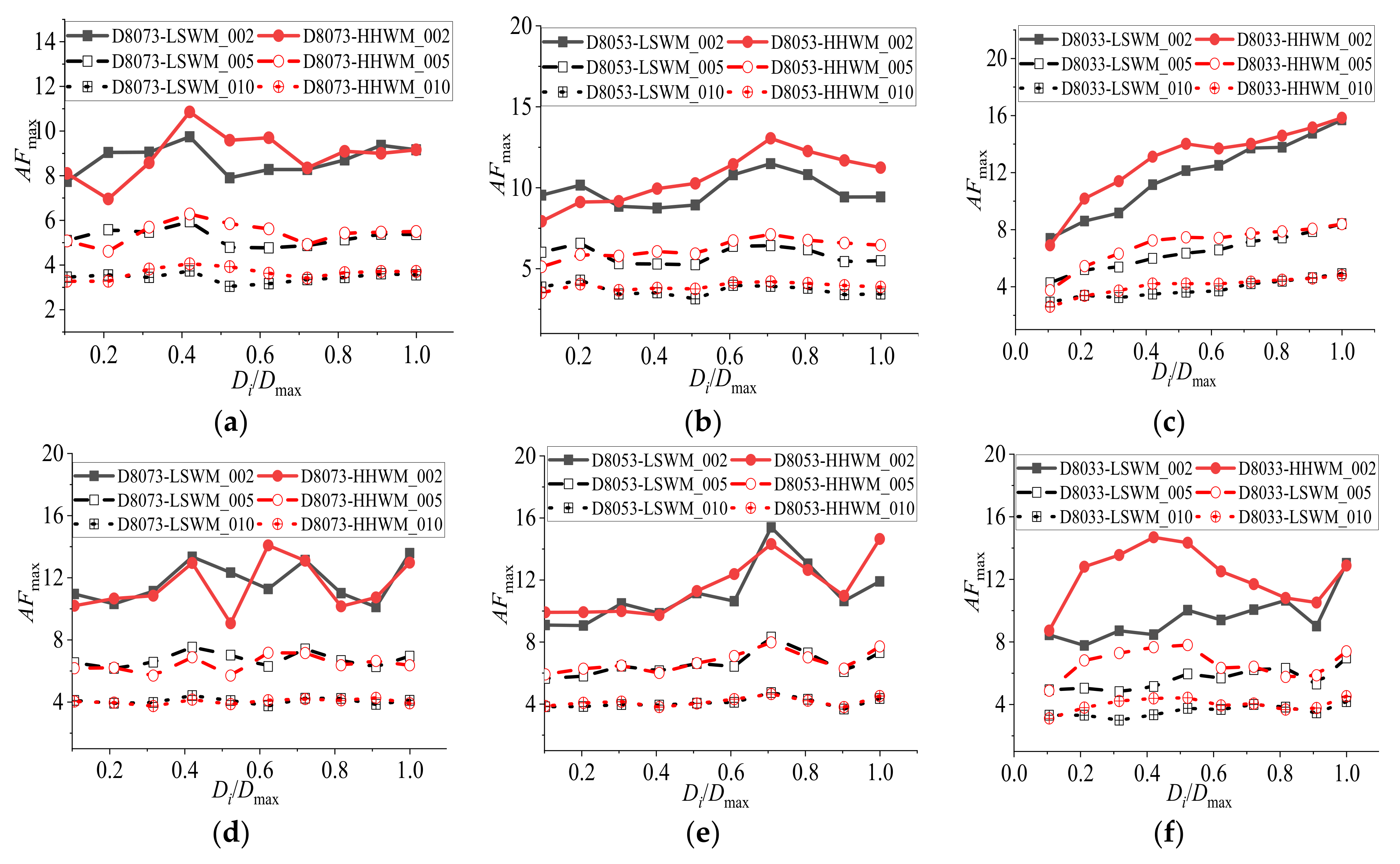

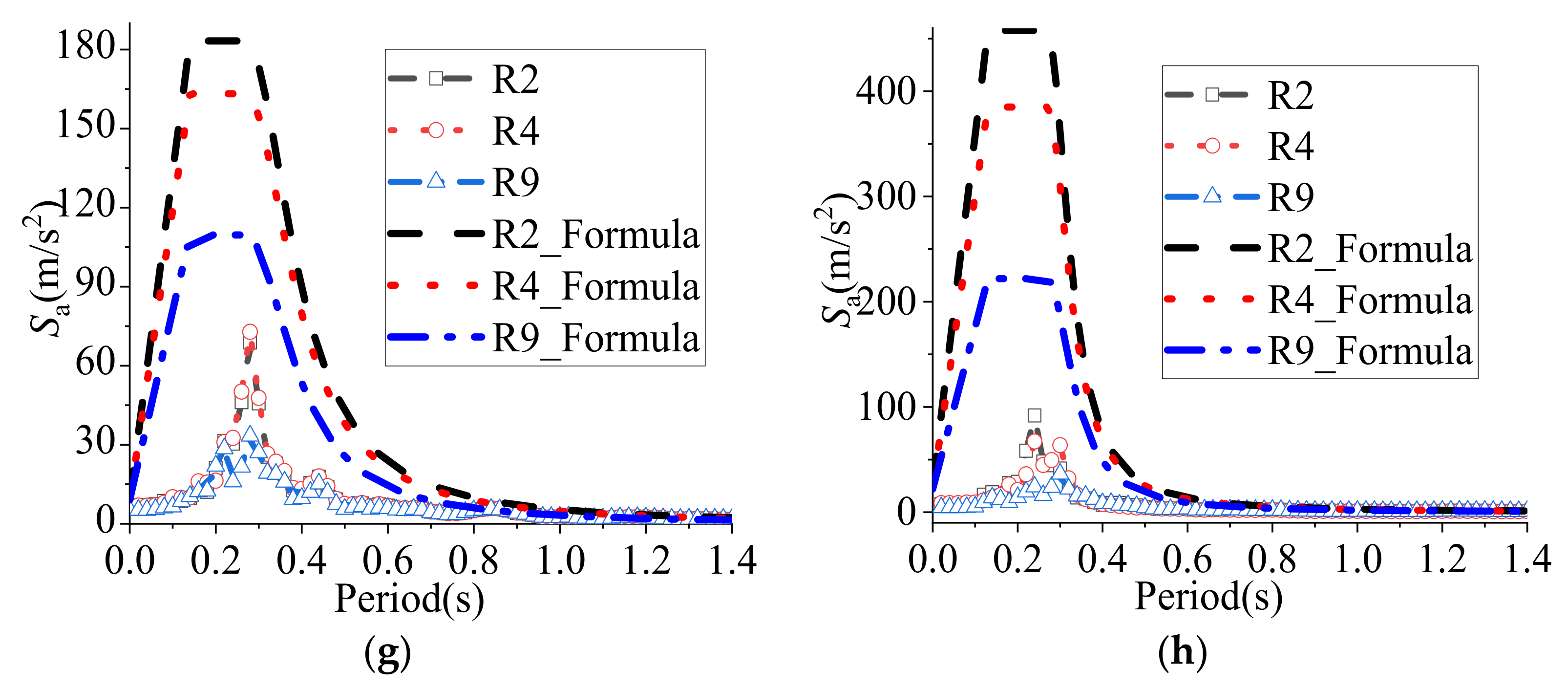
| No. | Codes and Standards | Calculation Formula |
|---|---|---|
| 1 | China: code for seismic design of non-structural components [10] | |
| 2 | America: minimum design loads for buildings and other structures [11] | |
| 3 | Europe: design of structures for earthquake resistance-Part 1 (general rules, seismic actions, and rules for buildings) [12] |
| No. | Name and Time | Station | Fault Distance (m) | PGA (g) |
|---|---|---|---|---|
| GM-1 | San Fernando (1971) | LA-Hollywood Stor FF | 22.77 | 0.17 |
| GM-2 | Imperial Valley-06 (1979) | Delta | 22.03 | 0.33 |
| GM-3 | Parkfield (1966) | Cholame-Shandon Array #8 | 12.90 | 0.28 |
| GM-4 | Kobe (1995) | Shin-Osaka | 19.15 | 0.08 |
| GM-5 | Duzce (1999) | Bolu | 12.04 | 0.37 |
| GM-6 | Imperial Valley-06 (1979) | Compuertas | 15.30 | 0.04 |
| GM-7 | Victoria Mexico (1980) | Chihuahua | 18.96 | 0.04 |
| Nonstructural Component | Functional Coefficient (γ) | State Coefficient (ξ1) | Position Coefficient (ξ2) | Category Coefficient (η) | Maximum Horizontal Seismic Influence Coefficient (αmax) |
|---|---|---|---|---|---|
| Billboard | 1.0 | 1.0 | 1.0–2.0 | 1.2 | 0.32 |
| Decorative connection | 1.0 | 1.0 | 1.0–2.0 | 1.0 | |
| Fireproof ceilings | 1.0 | 1.0 | 1.0–2.0 | 0.9 |
| Roofing System | Fitting Coefficient | A1 | B1 | C1 | D1 | E1 | F1 | G1 | H1 |
|---|---|---|---|---|---|---|---|---|---|
| Bolted purlin roofing system | AS1 | 5.03 | 1.32 | 0.16 | 0.016 | 4.99 | 42.26 | 7.25 | 9.31 |
| Welded purlin roofing system | 8.74 | 1.48 | 0.16 | 0.024 | 0.056 | 41.82 | 3.84 | 13.04 | |
| Bolted purlin roofing system | AS2 | 11.38 | −8.87 | 0.171 | 0.132 | 16.1 | 89.44 | 68.62 | −18.1 |
| Welded purlin roofing system | 11.98 | −10.38 | 0.116 | 0.093 | 16.2 | 44.52 | 55.26 | −14.9 |
| Coefficient | Bolted Purlin Roofing System Horizontal | Welded Purlin Roofing System Horizontal | Bolted Purlin Roofing System Vertical | Welded Purlin Roofing System Vertical |
|---|---|---|---|---|
| A | ||||
| B | 1.60 | 1.60 |
Publisher’s Note: MDPI stays neutral with regard to jurisdictional claims in published maps and institutional affiliations. |
© 2022 by the authors. Licensee MDPI, Basel, Switzerland. This article is an open access article distributed under the terms and conditions of the Creative Commons Attribution (CC BY) license (https://creativecommons.org/licenses/by/4.0/).
Share and Cite
Fan, F.; Zhi, X.; Li, W. Analysis of the Acceleration Response Spectra of Single-Layer Spherical Reticulated Shell Structures. Appl. Sci. 2022, 12, 2116. https://doi.org/10.3390/app12042116
Fan F, Zhi X, Li W. Analysis of the Acceleration Response Spectra of Single-Layer Spherical Reticulated Shell Structures. Applied Sciences. 2022; 12(4):2116. https://doi.org/10.3390/app12042116
Chicago/Turabian StyleFan, Feng, Xudong Zhi, and Wenliang Li. 2022. "Analysis of the Acceleration Response Spectra of Single-Layer Spherical Reticulated Shell Structures" Applied Sciences 12, no. 4: 2116. https://doi.org/10.3390/app12042116
APA StyleFan, F., Zhi, X., & Li, W. (2022). Analysis of the Acceleration Response Spectra of Single-Layer Spherical Reticulated Shell Structures. Applied Sciences, 12(4), 2116. https://doi.org/10.3390/app12042116





